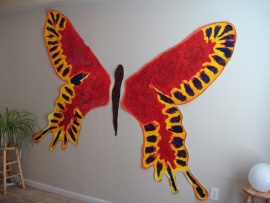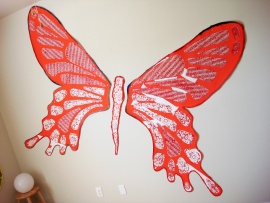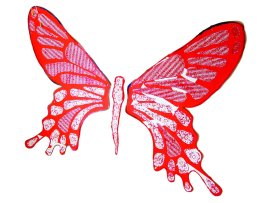 Some collectors purchase artworks to accentuate a room. The pieces in Delores De Wilde Bina's current exhibition at the Bucktown Center for the Arts, however, are the room.
Some collectors purchase artworks to accentuate a room. The pieces in Delores De Wilde Bina's current exhibition at the Bucktown Center for the Arts, however, are the room.
"Okay, so you hang one on the wall in your studio, and it's seven and a half feet tall," the Davenport artist recalls telling someone at the exhibit's opening. "That's almost floor-to-ceiling. And then the wingspan is eight-foot, and ... .
"Oops!" she exclaims with a laugh. "We've just filled this whole wall!"
Since her 2004 retirement from teaching at Williams Intermediate School, De Wilde Bina has exhibited her richly textured, colorful renderings of butterflies in paint, pencil, and collage at numerous Midwestern galleries. And during a recent phone interview, the artist states that most of her works have always been considerably larger than their real-life counterparts. "I did a few small ones in the three-, four-inch range," she says, "but generally the things that I was doing were 24, 30, 36 inches, which let me show the kinds of details that most people never saw."
But this past January, states De Wilde Bina, "I decided that I wanted to go super-size, I guess you could call it." The artist began work on her Big Bina Butterflies series, and nine of those pieces are on display at Bucktown through November 28. (Also included in the exhibit are several of the artist's smaller butterfly works, because, as she says, "I wanted people to see where I've come from.")
De Wilde Bina, who received her master's degree in art from the University of Iowa, says that her artistic attraction to butterflies began with a youthful curiosity about insects in general. "I was just fascinated with these small creatures that, once you got out a magnifying glass, had countless amounts of detail that people could never see," she says. "So I worked with insects for a while, and then I wanted to work with color, and so I became interested in butterflies."
She was also taken - as she is to this day - with the winged insects' symbolic history. "Butterflies represent different things to different cultures," says De Wilde Bina. "I find them fun, friendly kinds of things that kind of speak to life. But then you do a little more research, and you find that in another culture, they represent death. And then in some cultures, they're symbols that are used in the afterlife, and they're omens of good and bad luck. So they really have a lot of diversified meaning."
 Perhaps fittingly, De Wilde Bina approaches her butterflies with diversified methods. "I've always used existing species" as models, she says. "Basic characteristics. But sometimes I may work with the veins in a butterfly and that structure, sometimes with the colors of butterflies, sometimes with the backside - or underneath side - of butterflies, which can be totally different from the top side for camouflage purposes. I'm just mixing all of those ingredients together, and then from there on, it's just kind of free form."
Perhaps fittingly, De Wilde Bina approaches her butterflies with diversified methods. "I've always used existing species" as models, she says. "Basic characteristics. But sometimes I may work with the veins in a butterfly and that structure, sometimes with the colors of butterflies, sometimes with the backside - or underneath side - of butterflies, which can be totally different from the top side for camouflage purposes. I'm just mixing all of those ingredients together, and then from there on, it's just kind of free form."
Consequently, and beyond their larger-than-life size, the artist's vibrant renderings don't necessarily resemble any butterflies you'll find in nature - which suits the artist just fine. "My earlier ones were quite naturalistic, but as I became more interested in texture and pattern, they became more imaginative. And a couple of years ago, I took a trip to Mali, west Africa, and because of the season, saw very few butterflies. So that also made me decide, you know, if I can't see the actual thing," says De Wilde Bina with a laugh, "then let's use my imagination."
With even the smallest pieces in the Big Bina Butterflies series standing six feet tall by four feet wide, the artist's imagination is certainly at work in her current series. As is her patience.
"They do take some time," she says of her renderings, adding that even her smaller butterflies often require 50 to 70 hours of work. "You have to take into consideration the making of the templates, and the cutting of the shapes, and you have to wait for paint to dry for the layering kind of effect. So I may work on one for a couple of days, and then you have to put it aside and go on to another one. And you keep rotating back and forth."
She adds, however, that "I really like to sit down and spend long periods of time working, and not stop for other things. So it holds my interest."
Of particular interest to De Wilde Bina are the recycled billboards she uses for her big-butterfly canvases, which - along with all manner of potential canvases - she keeps stored in her Davenport studio. ("I guess you could call me a very early recycler," she says. "When I taught, people said, 'Don't throw anything away. Give it to Mrs. Bina.'") Rather than painting over them completely, the artist oftentimes incorporates their colors, images, and designs into in her works; in one particular De Wilde Bina Butterfly, for instance, you can see the unmistakable logo of a Goodyear tire.
"I'm very interested in pattern and texture," she says. "And so the billboards could have textural images on them that I work with and work around. Sometimes I add my own color to it; sometimes I paint and scratch into the paint's surface to create a texture. It's an ever-changing kind of thing.
 "You know," De Wilde Bina continues, "you see what you've got to work with, and some days it looks pretty good and you think, 'I can make use of that.' And then you look through another pile of stuff and say, 'O-o-o-oh, hey, this will work out just as well!'"
"You know," De Wilde Bina continues, "you see what you've got to work with, and some days it looks pretty good and you think, 'I can make use of that.' And then you look through another pile of stuff and say, 'O-o-o-oh, hey, this will work out just as well!'"
Though she says she doesn't have a particular favorite piece - "They're all my favorites when I do them, and then I'll get to the next one and say, 'Oh ... this is now my favorite" - De Wilde Bina does reserve the right to re-touch works that may be "completed" in name only.
"As an artist," she says, "you find that stopping place, and you say it's finished, and you may choose never to go back and do anything more with it. But I could also decide I want to add some more to it. I think an artist does that no matter what [medium] they work in."
As for what response this artist hopes to elicit from her large-scale works, De Wilde Bina says that ones of the pleasures of the Big Bina Butterflies series is that "there aren't any preconceived notions, and it all goes to personal preference. I had people come in the other night and say, 'Well, I like this one and this one best.' But the next person liked another one best. And you get to ask yourself, why do you like it? By not being a traditional, naturalistic, realistic image, it starts to provoke thought, and it makes the viewer find whatever is meaningful to them."
Delores De Wilde Bina's Big Bina Butterflies exhibit will be on display through Friday, November 28, at Bucktown Center for the Arts, and more information is available by visiting BucktownArts.com.










